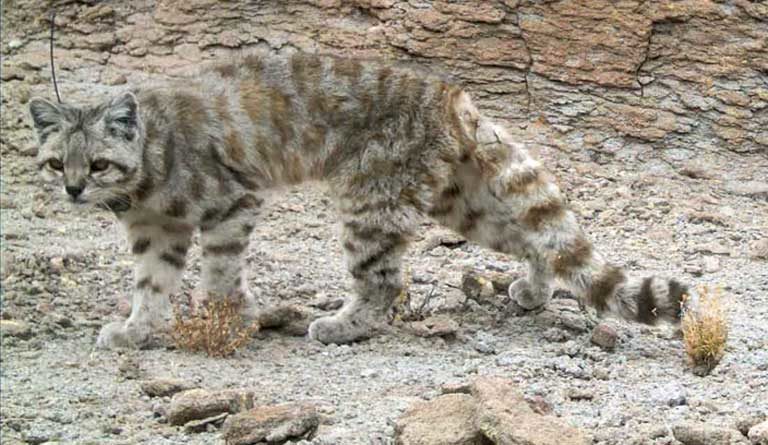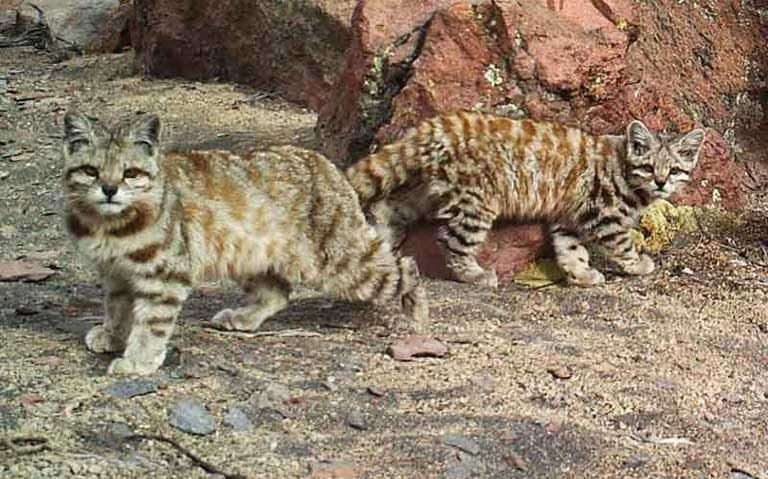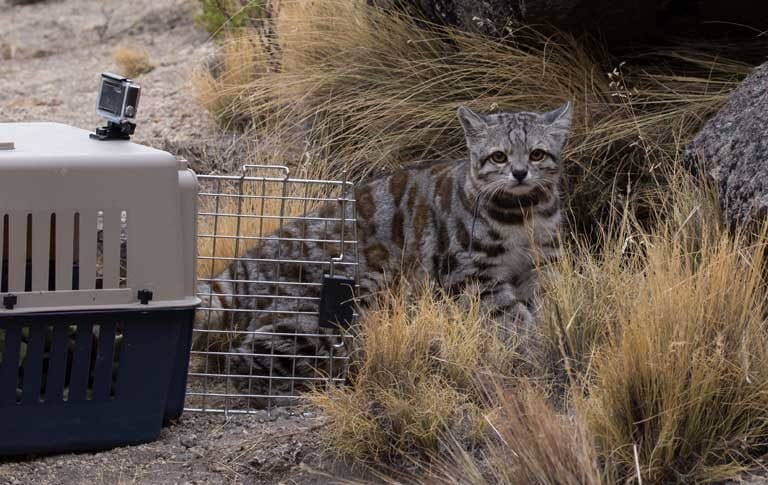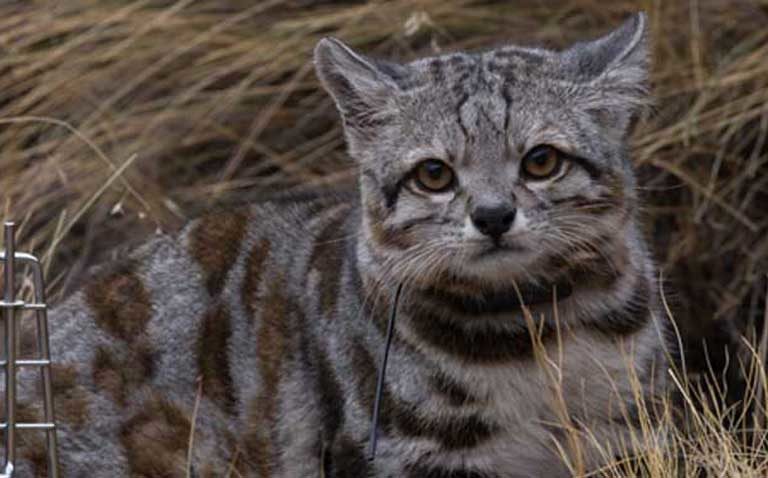- The Andean cat ranges from remote areas of central Peru to the Patagonian steppe. Perfectly adapted to extreme environments, this small feline is threatened by habitat degradation and hunting, but most of all it suffers from anonymity: it’s hard to save an animal that no one ever sees.
- So few of these endangered cats are scattered across such vast landscapes that even most of their advocates have never seen the species they’re trying to protect. But the conservation efforts that could save this cat could also preserve the wild places where Andean cats live.
- When a male Andean cat was found wandering around a soccer field, Andean Cat Alliance members agreed to forego the extraordinary opportunity to study the animal in captivity, and try instead to return “Jacobo” to the wild.
- Andean Cat Alliance coordinators Rocío Palacios and Lilian Villalba orchestrated the multinational volunteer release effort. Conservationists equipped Jacobo with a GPS collar and hope that tracking his travels will reveal new data about this secretive cat, considered a symbol of the Andes.

When an Andean cat (Leopardus jacobita) suddenly showed up in the middle of a synthetic soccer field in Bolivia, the wild feline was far from anywhere that should have been home. Not knowing what else to do, local people put the Endangered cat in a birdcage to hand it over to authorities.
How the housecat-sized feline ended up such a distance from its usual haunts — high in the mountains of Chile, Argentina, Bolivia and Peru — is still a mystery. However, the extraordinary circumstance gave conservationists a chance to learn about an animal they were dedicated to saving, but had rarely seen.
It isn’t easy to find an Andean cat. Only 1,378 adults exist, with the small cats scattered over more than 150,000 square kilometers (roughly 600,000 square miles) of highlands from northeastern Peru to Patagonia, according to the first population numbers published last year on the IUCN red list website. This single population estimate is one of the biggest successes of the Andean Cat Alliance because estimating the population numbers for such a low density species is a huge challenge, says Rocío Palacios, biologist and co-coordinator of the organization, which has teams of volunteers dedicated to protecting this wild feline across its whole range.


Although the cats live in remote areas, at elevations up to 12,000 feet, their habitat is rich with deposits of coal, oil and minerals such as tin, silver, and gold, so the reclusive feline increasingly competes with the mining industry for territory. They’re also threatened by local hunters who, in an effort to protect livestock from larger predators, often kill the small cats, too.
The thick-coated wild cats also suffer from an identity crisis. With so few prowling such a large landscape, most people don’t even know what they look like. If spotted, Andean cats may be mistaken for the pampas cat that lives in overlapping habitat. With such a low profile, it can be tough to generate support for conservation.
“This is more than saving a cat,” says Palacios. “This animal is a symbol of the Andes. When we talk about saving this cat, we’re talking about saving an entire landscape.”

Mongabay: What motivates you to save an animal you never see?
Palacios: I get that question a lot. At first, that was really hard to answer because I couldn’t understand this feeling that you need to see the animal that you are studying to be able to work with that animal.
I’ve always loved to study carnivores but where I live, in Argentina, there are no big lions. We have smaller cats and they are always on the move, so it’s really hard to find them. So, it’s detective work: I look for signs and tracks to deduce what the cats have been doing, how they interact with each other. From gathering evidence, we construct the life history. But it’s not just about the cat. The cat is a symbol of what I’m working for.
One of the most powerful experiences in my life happened the first time I went to the Andes, looking for the cat and collecting scat. I was sitting on a rock and couldn’t see any sign of humans — no people, no roads, not another human thing — in any direction. Even though I had been going to the mountains since I was a kid, I had never before experienced that feeling of completely blending with nature.
Conservation can be a really challenging profession; a lot of times it looks like the battle is already lost. The Andean cat is like my secret weapon, a symbol of that memory of totally blending into nature.

Mongabay: What have conservationists learned from Jacobo?
Palacios: Finding Jacobo was a powerful thing. The researchers and professionals who volunteer for the AGA (Alianza Gato Andino is the Spanish name for the Andean Cat Alliance) have worked together for a long time and we are always facing questions about the cat’s life history: How many kittens do they have? What is the breeding season? What is their phsiology? These are basic questions that we cannot answer because we’ve never had one in captivity to study. Before Jacobo, we didn’t even know the composition of the cat’s blood.
Immediately after Jacobo was found, it was determined the best place to keep him was at the Vesty Pakos State Zoo in La Paz [Bolivia]. They made special enclosures for him, so he wouldn’t get used to humans, and took very good care of him — he even gained a couple of pounds while he was there.
An inter-institutional committee was formed, organized by AGA, to follow up on everything related to Jacobo’s wellbeing. We planned to release him after the winter, when the weather wouldn’t be so harsh. Then he started to show signs of stress in captivity — a giant alert sign that we needed to release him very quickly. It began to feel like an emergency.
Even though we all wanted the same thing, it was hard to work together because people were in different countries and everyone has a “day job” to pay the bills. Also, the release process itself was complex. For example, we needed a blood test to make sure Jacobo was healthy before his release, but there was no lab in Bolivia that could do this, so the sample had to be sent to a specialist in Chile. This required special permits in a short timeframe. After the results came back okay, we needed trucks, release experts and a collar to track him. All of this costs money and — except for the trucks — the AGA financed most of these needed services.

The tracking technology is not well developed for small cats and you can’t just custom-order it for one individual. Only 5 Andean cats have ever been collared and we haven’t collected nearly enough information from them. The first cat, named Sombrita, was collared in Bolivia and about six months later she was killed by a local person who had issues with the protected area recently established in the region. Later, more cats were collared in Argentina, but each one had some kind of problem; the collars fell off too quickly or just stopped recording. There is just not proper technology developed for this kind of species, so most of our data has been from scat and camera traps.
Finally, everything came together and we released Jacobo in Sajama National Park, in Bolivia. After the first few days of tracking his radio signal, he began venturing farther away from the site.
Mongabay: What are the next steps for Andean cat conservation?
Palacios: Our immediate goal is to stop the hunting. When I was finishing my research in northern Patagonia, more than half of the records for that dissertation work came from dead cats. That’s more than 20 dead cats, a huge number for a low-density species.
Part of our mitigation program in Chile and Argentina includes training guard dogs to keep predators away from goat herds in the [mountain] communities. That way the small cats won’t get killed along with the mountain lions, which are the real livestock predators. We want to expand that program as quickly as possible.
Another part of that program brings artists to schools where they help children paint murals that show the Andean cat and his important place in the landscape. In these isolated areas, the schools are a gathering place for the community, so everyone sees these conservation messages.
We also need pure research at the population genetics level. It may sound boring, but I have a strong suspicion there may be two subspecies of Andean cats, and we need to know [whether that is true or not] to adjust our conservation actions.

Next year, we also want to start a monitoring network in protected areas. This was my main project in previous fieldwork. If this is well applied, the Andean cat becomes part of the action plan for protected areas. That works as a conservation tool because it helps detect sudden changes in population trends.
And of course, there is Jacobo. We need to keep following him. He was released in a very remote site, in a park that straddles Bolivia and Chile. When we went to the field to look for [radio collar] signals in October, November, and December, there was a far away signal once, and then never again. We are trying to arrange an overflight to look for him one more time before the radio battery dies.
Even though it’s disappointing not to know exactly where he is, it’s a good thing that Jacobo moved away from his release site, looking for a proper place to make his own territory. He is out there somewhere and, because every individual matters, we know we did the best thing possible by releasing him.
Jacobo is a lot more than just another cat for us; he’s a symbol of the Andes. Like a living being needs a soul, the soul of the Andes is represented by Jacobo.
For more on the topic:
Lucherini M, Palacios R, Villalba L, Iverson E. (2012) A new Strategic Plan for the conservation of the Andean cat. Oryx. Vol. 46, pp. 16-17.
Novaro AJ, Walker S, Palacios R, et al. (2010) Endangered Andean cat distribution beyond the Andes in Patagonia. Cat News. Vol. 53, pp. 8-10.
Villalba L, Lucherini M, Walker S, Lagos N, Cossios D, Bennett M, Huaranca J. 2016. Leopardus jacobita. The IUCN Red List of Threatened Species 2016: e.T15452A50657407.
Walker S, Funes M, Heidel L, Palacios R. (2014) The Endangered Andean cat and fracking in Patagonia. Oryx. Vol. 48, pp. 14-15.

